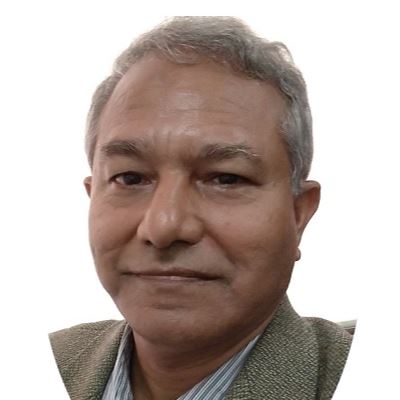
Bhupendra Nath Dev
Professor
Email: bhupen.dev@tcgcrest.org , bhupen.dev@gmail.com
Currently an Honorary Fellow of S. N. Bose National Centre for Basic Sciences, Kolkata, Prof. Dev was a Visiting Professor in the Department of Physics and School of Nano Science and Technology in the Indian Institute of Technology Kharagpur (2017-2020). Earlier he was a Senior Professor at Indian Association for the Cultivation of Science (IACS), Kolkata (2006-2017) and prior to that a full Professor at Institute of Physics (IOP), Bhubaneswar. He received Ph.D. in Physics (1985) from the State University of New York at Albany, USA. He worked as a Guest Scientist at Hamburg Synchrotron Radiation Laboratory (HASYLAB) at DESY in Hamburg, Germany and then returned to India and joined IOP in 1988. At IOP he set up an ion beam laboratory with ion scattering and ion implantation facilities, which include an ion microbeam facility, developed in collaboration with his alma mater State University of New York. His doctoral student, involved with the ion microbeam project, later went on to develop an ion nanobeam facility at the University of Melbourne as a postdoctoral fellow in the group (of Prof. D. N. Jamieson) working on quantum technology involving single ion implantation in silicon (qubit fabrication by P implantation into Si).
Prof. Dev also indigenously set up the first X-ray reflectivity and X-ray standing wave facilities in India at IOP with an 18 kW Rigaku rotating anode X-ray generator. His group has shown that the XSW technique is able to trace atomic displacement with an extremely high resolution (~ 2 Angstrom). This helped understanding of ion irradiation-induced nonmagnetic to ferromagnetic transformation in multilayers.
In 2001 Prof. Dev initiated research in nano and quantum science by setting up a combined molecular beam epitaxy (MBE) and ultra-high vacuum variable temperature scanning tunneling microscopy (STM) facilities. The MBE system was based on his own design and fabricated by Omicron Nanotechnology. His group published the first work from India on MBE-grown self-organized epitaxial nanostructures and their STM and transmission electron microscopy investigations. His group worked on single-electron tunneling via scanning tunneling spectroscopy (STS) and the simulation of I-V behaviour including the effect of quantum capacitance. Metal atom doping of one-dimensional (1-D) silicon (3-atom wide line) structures and the associated modifications in the electronic structure, e.g. band gap broadening, band edge shift, emergence of new electronic states within the band gap etc. were investigated by STS and explained by a one-dimensional tight-binding model with Green’s function approach.
At IACS, Prof. Dev set up a laboratory with a combined MBE-VTSTM-PEEM (photoemission electron microscopy) facility for research on quantum structures. Sputter deposition facility and SQUID-VSM were added to supplement this research. Quantum dot structures of semiconductors were grown on silicon by MBE with shape control, and consequently electronic energy level control, and investigated by STS. Quantum structures within the dimensional cross-over regimes near the 2-D limit were grown by depositing metal layers (1-atom to 5-atom thick) on Si surfaces and their electronic structure and transport, like negative differential resistance (NDR) behaviour, were investigated by STS with an understanding via simple free-electron model simulation as well as density functional theory calculations. Prof. Dev also completed a Rs. 10 crore project on quantum structures, supported by the Department of Atomic Energy.
Atomic migration due to applied voltage pulses from an STM tip on a metal surface was investigated by STM, revealing the time evolution and formation of one-atom thick fractal structure via diffusion limited aggregation.
More recently, Prof. Dev’s group has discovered superconductivity in cobalt. Earlier they discovered a high-density nonmagnetic phase of cobalt in cobalt thin films on silicon. This high-density nonmagnetic cobalt is superconducting. Interestingly, in the cobalt film
a self-organized superconducting(S)/ferromagnetic(F)/superconducting(S) trilayer has formed. In fact, S/F/S hybrid structures are fabricated by depositing conventional superconducting and ferromagnetic materials by various research groups in the world for quantum information processing applications.
Prof. Dev has supervised 21 Ph.D. theses and published over 160 papers. He is a member of Editorial or Advisory Editorial Board of several international and national journals. He has served as a member of several programme advisory committees (PAC) of DST and SERB of Government of India [Condensed Matter Physics and Materials Science (twice), Physics and Astrophysics] and other DST expert committees [Expert Committee on Nano Science and Technology Initiative (NSTI), Expert Committee on Review of Accelerators]. As principal investigator, he has carried out international bilateral Indo-US, Indo-German and Indo-Japan collaborative research projects. Prof. Dev is a Fellow of the Indian Academy of Sciences and the National Academy of Sciences, India. For his doctoral thesis, he received the Presidential Distinguished Doctoral Dissertation Award (1985). Among other awards Prof. Dev received are 2009 DAE-Raja Ramanna Prize in Physics, the 2010 International Alumni Award for Exceptional Achievement from the University at Albany, State University of New York, U.S.A., the MRSI medal (2003) and the MRSI Distinguished Lectureship Award for 2015-16. Prof. Dev was awarded the senior Marie Curie International Incoming Fellowship (IIF) of European Union. With this fellowship Prof. Dev spent a year as EU Guest Scientist at Helmholtz Centre Dresden Rossendorf, Germany in 2005. Recently (2021) Prof. Dev was offered the Raja Ramanna Fellowship of the Department of Atomic Energy, Government of India.